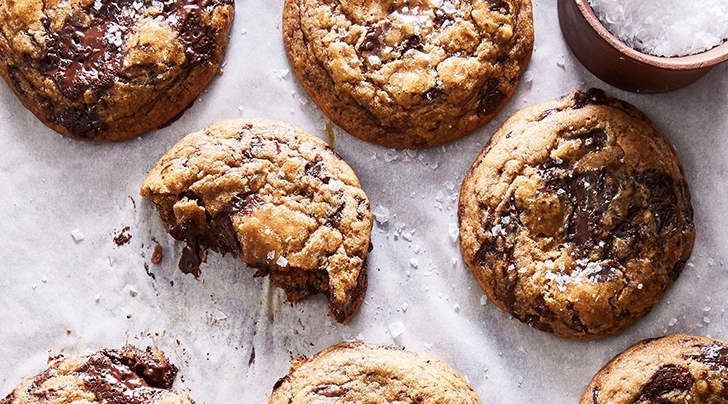Who doesn’t like cookies? This delicious dessert is always present at snacks, parties, Christmas or simply whenever you feel like it. Enjoying that fragrant smell, spreading through our house is indescribable. Hmm! However, although the cookies seem simple to prepare, you always have to pay the hazing and… it happens to all of us. What to do with hard or soft biscuits when they have turned out contrary to what is written in a recipe?
 Although there are many types of undesirable results when baking cookies, the most common are two: cookies that are too hard and cookies that are too soft. However, although they seem like a problem, at first glance it is not. Why? Keep reading this article on why are my cookies hard? And soft? And you will discover many reasons, tips and culinary secrets.
Although there are many types of undesirable results when baking cookies, the most common are two: cookies that are too hard and cookies that are too soft. However, although they seem like a problem, at first glance it is not. Why? Keep reading this article on why are my cookies hard? And soft? And you will discover many reasons, tips and culinary secrets.
Types of homemade cookies
Are soft or hard cookies a problem? Depends. In principle, the cookies are not all hard, nor are they all soft; this depends on the type of cookie. However, if you prepare one type of cookie and the opposite comes out, there is a problem. That is, you prepare soft cookies and they come out hard. For this reason, it is interesting to know a little about the types of cookies that exist:
Biscuits on the bar
Bar biscuits are very curious, since they are in between cakes and biscuits. Although they are baked in pans like cakes, they are cut into bite-sized pieces. Examples of this type of cookies are brownies and shortbread.
Butter cookies
This type of biscuit has very consistent dough, very similar to cake. The texture of the dough allows it to be stretched and cut in many very creative ways. These cookies can be covered in royal icing or decorated in endless different ways
Spoon cookies
Why are they called spoon cookies? The answer is very simple: because they are placed on the plate directly with a spoon. This technique is applied because the dough is very sticky (contains a lot of fat) and cannot be stretched with a rolling pin. These cookies expand in the oven, taking on a circular appearance.
Why do I have heard cookies?
What is the most common when we bake cookies? That they remain hard… Even many times! Don’t lose your cool; it happens to all of us. Hard cookies have a solution. For this reason, here I bring you some possible reasons and at the same time some very useful tips to achieve fluffy, soft and delicious cookies. The culinary secret that we all want to know out loud:
- You kneaded the preparation excessively. You worked the dough too much, therefore the gluten developed too much. Solution? When you knead, do it very little, especially if you have already added the flour. The important thing is to integrate the ingredients completely, the extra work is unnecessary.
- You added too much flour. Correction? Use a measuring cup to accurately calculate the amount of flour or weigh the portion. Preferably, never grab the flour directly from the package with the measuring cup, avoid using any cup other than the measuring cup and do not calculate “by eye” because you can go overboard with the measurements. Apply shallow measures.
- You used flour with a lot of gluten(protein), for example strong flour. What should you do? You can correct it by replacing it with another with less protein. What is the type of flour recommended for cookie dough? Loose flour (0000 or T45) or cake flour. However, if you prefer fluffy cookie recipes (also depends on the recipe), you can substitute a portion of flour (up to a quarter of the total) for cornstarch. Another alternative is to replace the flour (also up to 1/4 of the total) with ingredients such as cocoa powder, melted chocolate or ground nuts.
- You added little fat. The solution is simple, put ¼ cup more butter, so you will get more tender cookies.
- You added little sugar. What should you do? Add ¼ cup more sugar.
- You chose a dark or black cookie sheet. It is recommended that you use aluminum trays instead of black ones. Why? Exclusive aluminum biscuit baking pans have a very thin structure, and this allows for even baking. In addition, this melts the sugar and the biscuit acquires a golden color.
- You baked them for a long time. Check the temperature of your oven, remember each oven has different heat intensities and for this reason the cooking times vary. Cook the cookies for less time than recommended by the recipe, always monitor the appearance of the cookies, until you get the indicated time.
- You cooked the cookies at the same temperature all the way through. Lower the temperature a few minutes before the end of cooking, so the cookies will get a softer texture. Use this tip for your fluffy cookie recipes.
- You removed the “done” cookies from the oven. It is very common for cookies to appear to be ready, when in fact they are a bit overdone. The secret will be to check if they are ready, before removing them from the oven. To the thick cookies press them with a finger, and if you leave a mark, you can remove them from the oven. While the thin cookies at their point feel solid to the touch and the edges look somewhat golden.
- You selected butter instead of shortening. Although butter leaves a delicious flavor on the cookies, shortening melts at a higher temperature, so the cookies spread less during baking. What causes this? Less thin cookies have less surface area, so less moisture evaporates and slows the rate at which the cookies harden. Result? Soft cookies!
- You forgot to chill the cookies. The correct thing is to first wait 5 minutes on the baking tray and then place them on a rack until they cool completely. Then store the cookies in an airtight container with a piece of bread at the bottom. This way, they will stay soft.
How to soften hard cookies?
You baked a bunch of cookies and they got hard. Do you think to throw them away? Forget it! If you don’t know what to do with hard cookies, here’s a foolproof and uncomplicated trick. You will see how simple!
Add a slice of bread to the container where you keep the cookies. Yes, believe it or not, by adding bread to the bottom of a jar (preferably glass), a container with a lid, or even a plastic bag, the cookies will soften. If you don’t have bread, you can also place some popcorn. It is important that you close the container and do not open it until a period of 24 hours has elapsed. The next day…surprise! A soft and digestible biscuits. Remember to change the piece of bread (or popcorn) every day, so the cookies will stay soft for a while.
Why does this happen? When a hard cookie and a piece of fresh bread sit in a container for 24 hours, two events take place. The cookie absorbs moisture from the air, while the bread evaporates its moisture inside the container. At that time, the moisture in the bread is absorbed by the sugars in the cookie. Final score? Some tender biscuits and a stale bread.



